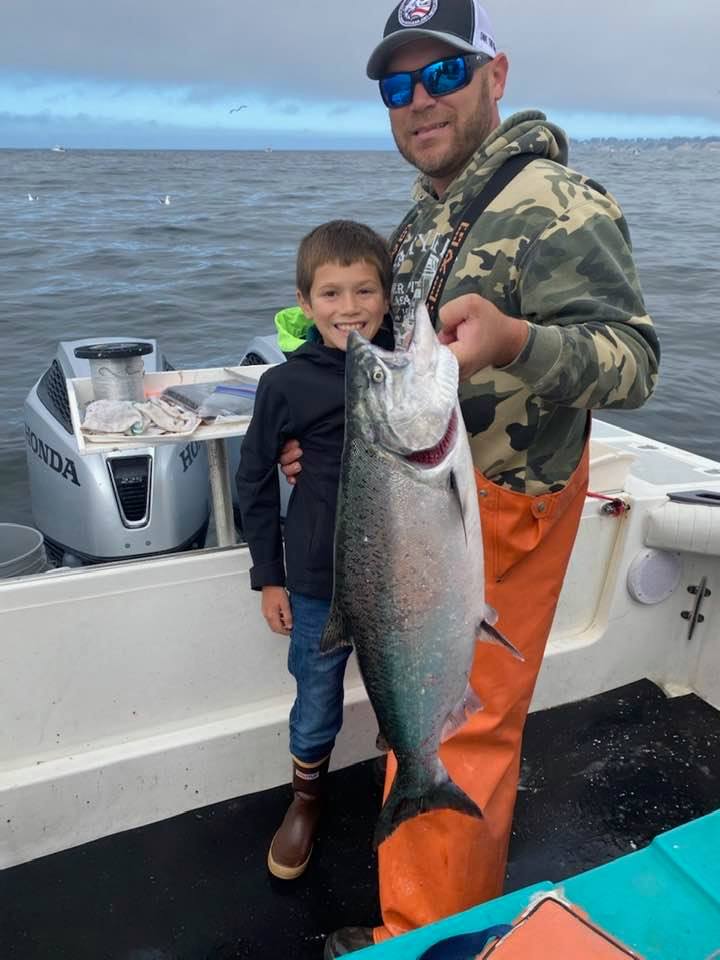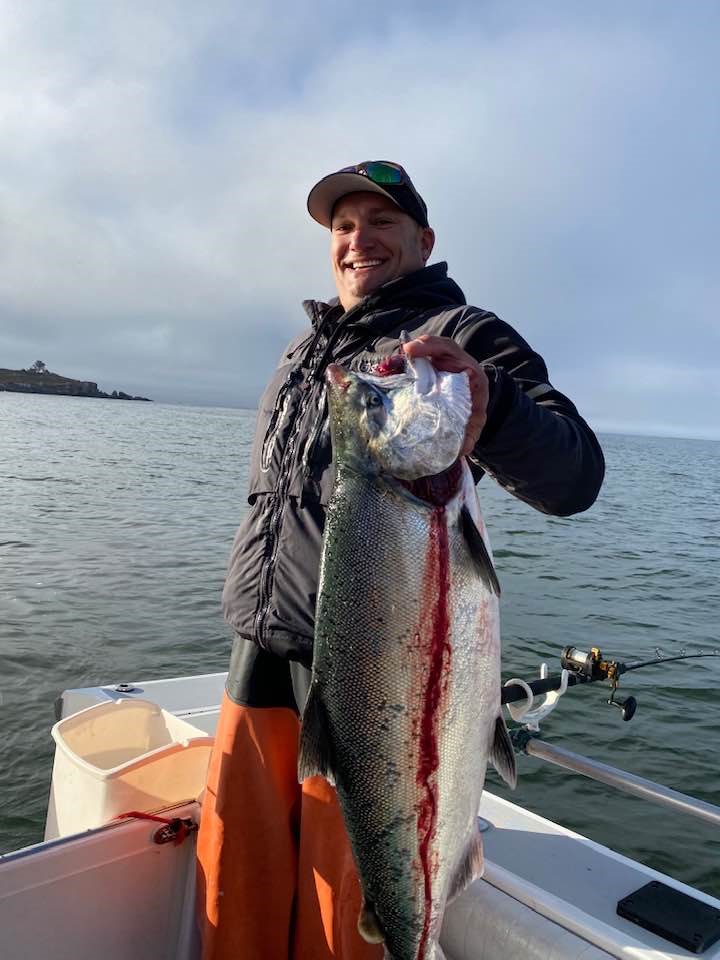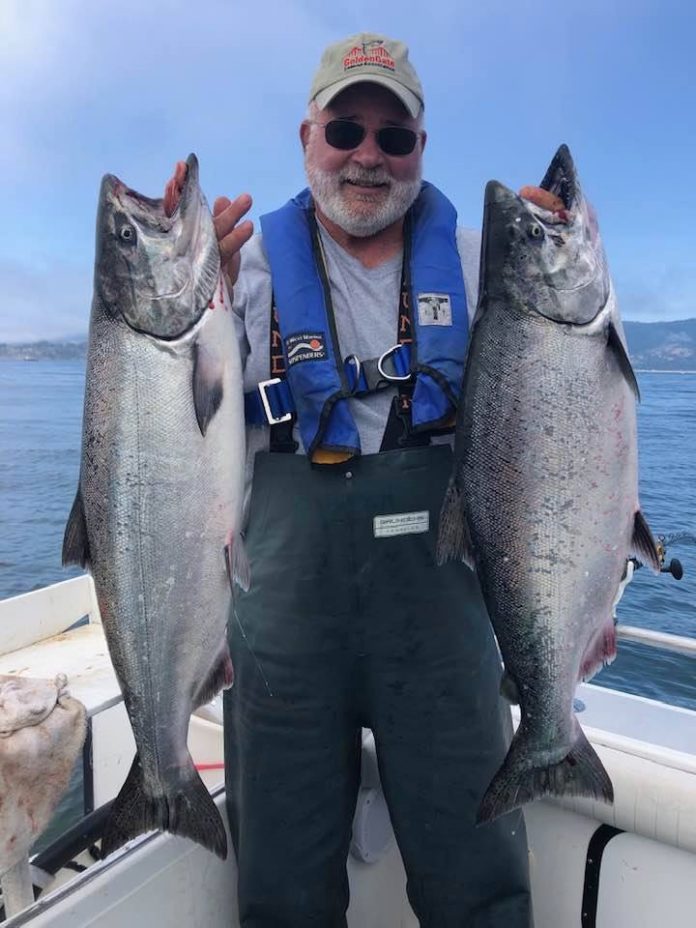BY DAVE HURLEY
As in most things in life, timing determines our success or failure whether it is in a relationship, applying for a job, or making a major life change. Success or failure at fishing isn’t really much different, and timing is perhaps the most important factor whether you return with a box loaded with fish or come back empty-handed. Mooching, or drifting, for salmon in the ocean is one of my favorite methods of fishing, and when the conditions are right, it is the time to get out there to watch the rod load up and get set for a fight.
Mooching for salmon is a technique that is absolutely dependent on timing, and although most salmon fishermen would prefer to mooch instead of trolling for salmon, the majority of private and party boats will troll close to 100 percent of the time since it is the most effective technique the majority of the time. Mooching requires the salmon to be in tighter schools working bait below the surface. As opposed to trolling, you cover far less water in your search for the salmon, relying on the signs of birds, bait, and whales in addition to your electronics to stay on top of the fish. Captain Trent Slate of Bite Me Charters out of Loch Lomond Marina knows that it is time to mooch once the salmon hit the baits while the boat is slowing down while trolling.
2020 has been consistently inconsistent for salmon fishing along the Marin coastline, and there have been flurries of action for a few days followed by days of a scratch or even no bite. Slate is one of the only sport fishing captains to mooch along the Marin coastline, and this season has been one of great success followed by less-than-stellar action. However, when the bite is on, memories are made. According to Slate, when you make the commitment to mooch, it is important not to overthink and switch over to trolling despite a natural inclination to second-guess yourself. He said, “I’ve noticed that if the conditions are right, the salmon will bite at some part of the day, and you have to stick with your game plan and be patient.”

A mooching rig is very simple, consisting of a light, flexible rod loaded with either braid or monofilament main line with a sliding sinker rig before a barrel swivel on a five-foot 25-pound test fluorocarbon leader and a circle hook. Tray anchovies, herring, or sardines are threaded through the body towards the head with a needle, and the hook is inserted into the mouth of the bait. A torpedo sinker of varying weight depending upon the current adds the finishing touch to this rudimentary set up. Now, the key is to find the right depth, and it is always better to be above the fish rather than below as salmon will come up and grab a bait, but they rarely go down to find a bait. After counting down the number of pulls you want to set you bait at, it is a matter of setting your rod in the holder, keeping the line vertical as much as possible by selecting the right weight, and being patient for the subtle little touches that identify a salmon picking up the bait.
Of course, this is the easy part. The hard part is knowing how to set up for the drift, keeping all lines vertical while moving through the current. When you are out with an experienced captain like Slate, you notice he is continually paying attention to his surroundings, watching the graph for bait, evaluating the color of the water, observing the bird action, and keeping an eye on the surrounding fleet to notice any nets flying. Slate looks for murres working the surface which he calls, “Good Luck Ducks.” Diving pelicans are another solid sign of something good happening below the surface. He said, “Cormorants lie, but seagulls can give you some idea of bait in the area.”
In addition to not wasting a 2.5-pound lead ball on every hook-up, mooching allows you to pay attention to the scenery along the incredible California coastline. There is nothing like sitting patiently on the bow of the boat and watching pelicans dive-bomb within 10 feet along with whales working the bait schools with the fog lifting over the coastal mountains with their varied and spectacular rock formations.
One of the most difficult aspects of mooching is allowing the salmon to swallow the bait, and many times, fish have been lost without even getting a hook-up due to an overanxious angler. Similar to halibut fishing with live bait, you have to allow the salmon to load up the rod before you start reeling instead of attempting to set a hook. Many a salmon has been left with a sore mouth when someone tried to set the hook. However, once the hook is set, you are in for a spirited fight on light tackle. Sometimes the salmon will come up quickly to the boat without recognizing that it has been hooked, but once the boat is in sight, the fight is on.
Twice this season it has been my day on Slate’s boat as I have contributed to boat limits with a total of six salmon ranging between 18 and 25 pounds, but as I mentioned earlier in this story, timing is one factor that determines success. On my first trip, I landed consecutive 25-pound salmon within five minutes, and the fun part of mooching with light tackle is the fish will run you around his 27-foot Boston Whaler one or two times. Pandemonium ensues when multiple fish are hooked, and we were fortunate to land all three big salmon on a triple hook-up on one trip.

Ocean salmon are the ficklest of any species, and the third time was not the charm as we had six rods out without even a scratched bait for our efforts. Due to the overall inconsistent action, Slate had been trolling recently after the mooching season peaked in July, but since the bite had been slow, he decided to throw a different look at the salmon. It was just one of those days as despite private boaters, six-packs, and large party boats working the same area from Duxbury Buoy south to Rocky Point both close to the shoreline and offshore, the high boat returned with only three salmon.
There is optimism for one more major push of salmon coming down from Bodega Bay around the corner from Point Reyes as the salmon are moving quickly towards the Golden Gate into the Sacramento River system. The scores have been far less than a fish per rod, but the salmon have all been hefty ones – I didn’t hook a fish less than 18 pounds this season. As the salmon seem to be moving in small groupings of large fish, mooching may not be the most effective technique for the remainder of the season as covering more water is the key. As mentioned at the start, timing is nearly everything in life, and the window for mooching may be over for this season. However, when it is on, it is on!
Slate can be reached at (415) 307-8582 or Bite Me Charters on Facebook. Loch Lomond is one of the cleanest marinas around with easy highway access, an upscale market on site with a full deli, and easy parking and access to the boat.



